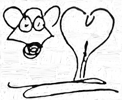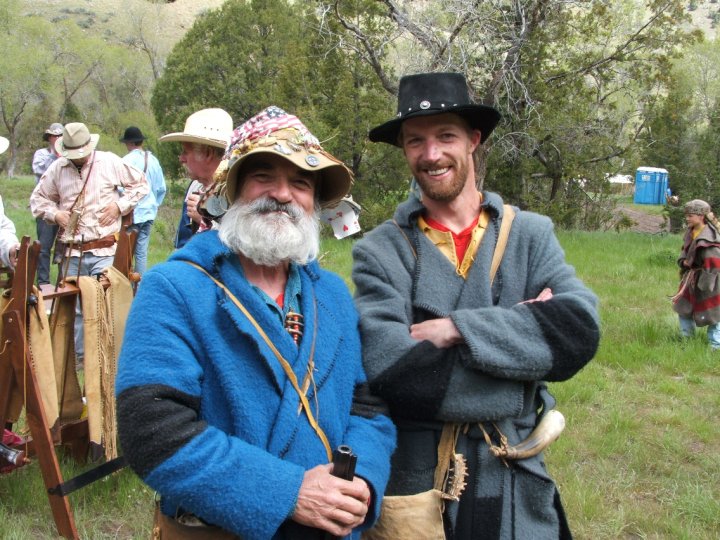First off let me tell you right up front that this explanation is intended for the novice, so that when someone hands them a muzzle loading rifle they should be able to say, “Oh, this is a nice__whatever it is________gun”!
Which came first the chicken or the egg? You decide for yourself and then please keep the answer to yourself…thank you!
Which came first the flintlock or the cap lock? The flintlock came first! Well, let’s just say, the flintlock came before the cap lock. There were other guns that preceded the flintlock, but that is not what we are talking about here.
Both guns have a barrel and stock and a lock assembly and trigger assembly and a ram rod. Some of both types even have sights on the rear and the front. Have you ever heard of “Lock, Stock and Barrel”?
So what is the lock?
Flint lock, get it? Cap lock, get it?
Flintlocks have a few pieces that aren’t on a cap lock. So here we go with the difference. The flintlock, now going to be called a “flinter”, has a screw down mechanism that is an integral part of the hammer, that allows the user to pinch a small piece of flint rock (that’s ROCK not LOCK) in it. Most often the user will also employ a small piece of leather or cloth between the metal of the screw down mechanism and the flint rock (ROCK). This keeps the flint rock (what?) from breaking under the pressure the mechanism exerts on it.
The flinter also has to have something for the flint rock to strike against to cause a spark. You see the whole idea behind a flintlock is to get a spark to ignite powder and set the main charge in the gun off. When you make a fire using a piece of flint and a steel striker, you strike down onto the edge of the flint with the steel striker, which causes sparks to cast about and land on your char cloth. Then you place the char cloth into a nest of very dry wood shavings or other material called tinder. Then you blow into the nest until it bursts into flame. Trust me on that.
The flintlock (LOCK not ROCK) works on the same principle utilizing the flint rock (ROCK not LOCK) striking the steel of what is called the “frizzen”. The frizzen on the gun can pivot and it pivots towards the front of the gun. The frizzen is also held rather tightly by a strong spring, called a main spring, which makes the flint really have to bear down some pressure to get the device to pivot. As the flint basically scrapes down the face of the frizzen, the frizzen moves away and the flint continues it’s downward motion cascading sparks as it moves. As the frizzen moves out of the way, it exposes finely ground gun powder (blackpowder) that is housed under the frizzen in what is called “the pan”. The sparks are hot pieces of metal shavings that the flint rock has scraped away from the face of the frizzen and they fall into the gunpowder and cause it to explode (burns really fast). This explosion is nothing but pure fire and some of this fire is cast into the main powder chamber inside the guns’ barrel through what is called the “touch hole”. The touch hole is nothing more than a hole in the side of the barrel that goes from the outside world into the inside of the guns barrel. If you point the muzzle end of the gun barrel toward the sun, and press your eye very tightly against the touch hole, you might be able to see some light coming in. Of course that would only work with a gun that was not loaded.
Ok, here it goes, the flint is held tightly in the mechanism of the hammer, a small amount of powder has been placed in the pan, and the frizzen is pulled back and pressed downward over top of the pan. The hammer is then cocked all the way back. The gun is pointed downrange toward the intended target. Hopefully some aiming is taking place and the trigger is pulled until the hammer falls. The flint hits the frizzen, pressure from the main spring attached to the frizzen is exerted, but the force of the hammer spring is greater than that of the main spring and the frizzen begins to move away from the flint rock. Sparks begin to fly and continue to fly until the frizzen is completely moved away from the flint rock. The hammer stops short of hitting the pan, which holds the powder. By the time the hammer stops, the sparks have ignited the powder in the pan and has caused a small explosion. Fire goes into the barrel through the touch hole, where a charge of powder and a seated projectile await. The main powder charge ignites and sends the projectile down toward the intended target.
That is how a flintlock works.
Now let’s talk about the cap lock gun.
Lock, Stock and Barrel! Stock? Pretty much like that of the flinter. Barrel? Pretty much like that of the flinter, differences to be explained shortly. Lock? A substantial difference.
Lock. The hammer does not have anything that needs to be tightened in it like the flinter does, so it just has a cupped face.
Barrel. The touch hole in the barrel is threaded and a “drum” is screwed into this touch hole. The drum also has a threaded hole in it. A “nipple” is screwed into the drums’ threaded hole. With the whole assembly in place, the cupped face of the hammer, will fit exactly over the top of the nipple.
I sense confusion.
Drum. A cylindrical metal device used to basically extend the touch hole. The threaded touch hole allows the drum to be screwed into the barrel and makes a tight seal against the barrel.
Nipple. A metal device threaded on one end and tapers in a cone like shape. The nipple has a small sized hole extending its’ full length. The nipple is screwed into the drum. In essence, the touch hole of the flintlock rifle has now been extended out at a 90 degree angle away from the barrel, and then turned another 90 degree angle upward and toward the rear of the barrel. Close your eyes and try to visualize this in your mind as someone reads this to you. Keep doing this until you clearly see what I mean.
Now that you have seen it.
A cap, what’s a cap? A cap is a very small metal cup that has a very small charge of extremely finely ground black powder in it and is covered by a very, very thin layer of waterproof material.
A cap, is placed over the top of the cone shaped nipple. The hammer is cocked. When the hammer hits the top of the cap, forcing it down onto the top of the nipple, the pressure on the powder charge inside the cap, causes it to explode. Since the hammer has a grundle of pressure being forced downward on the top of the cap, which is the pressure caused by the spring operating the hammer, the explosion has nowhere to go but down through the hole or channel of the nipple, into the drum and then into the barrel where the main powder charge is waiting, just like with the flinter.
Advantages and disadvantages of each.
Flinter Advantages: None, except you really look cool shooting one at rendezvous and especially cool if you are winning prizes in the contests. Disadvantages: Lots! An extra spring to break. A flint rock that almost always needs tending to. The flint rock holding device could strip out. Almost impossible to keep things in working order when the weather is wet. An exploding mass of fire right in front of your aiming eye. A delay between pulling the trigger and the main charge going off. A miriade of stuff.
Cap Lock Advantages: Tons over a flinter. Simple design. Can be used in inclement weather a whole lot better. You don’t have to have a bunch of extra rocks and tools. No fire flashing in front of you. And nearly instant ignition when you shoot. Disadvantages: You don’t look as cool on the firing line at rendezvous as a guy with a flinter. Bragging rights are diminished if it’s just you against a flinter shooter and you happen to win.
OK, School is over!
Bears Butt
June 8, 2011


 Utah Fishing Reports
Utah Fishing Reports
Very informative. Thank you for explaining this to people who did not understand the differences, and did not want to have to scour the internet to find a down to earth explanation
Straightforward and helpful information. Thank you for the explanation with a sense of humor.